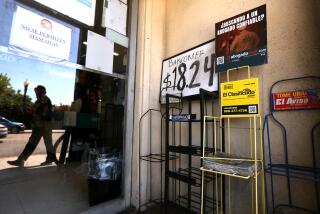After 96 Years, Tribune Passes Into History : Press: Final edition marks death in the afternoon of the feisty publication that won two Pulitzer prizes.
- Share via
The San Diego Tribune passed quietly into history Saturday, its readers reluctantly paying their last respects at newsstands throughout the city that the afternoon daily has served for the past 96 years.
More resigned than mournful at the death of another American newspaper, readers and souvenir hunters bought final copies of the Tribune and its more well-to-do sister, the Union, both of which appeared for the last time as separate publications Saturday. The two will merge into the San Diego Union-Tribune, a morning daily, today.
“It seems kind of sad,” said Jessie LaConte, who picked up her copy as she waited for a bus in North Park. “It’s been around for so long and now it’s dying. Times are changing.”
“I always feel bad when a paper’s gone,” said Helen Terry Massie, a 20-year reader of the scrappy afternoon paper, who has watched newspapers fold in New York City and elsewhere. “You’re losing two sides of a situation and a story.
“We’re gonna miss it. A lot of us are gonna miss it.”
The Tribune succumbed to the same diseases that have claimed at least 35 other U.S. newspapers over the past two years: The powerful influence of television and changing readership habits that have frustrated publishers’ efforts to attract and retain readers without the time to devote to an evening publication.
Founded in 1895 as the Evening Tribune, the newspaper was purchased by the Copley Press in 1928. It won journalism’s top award, the Pulitzer Prize, twice--in 1979 for the coverage of the midair collision over North Park that killed 144 people and in 1987 for editorial writing on immigration affairs.
The Tribune boasted San Diego’s highest newspaper circulation as late as 1966, but its readership had fallen to less than half that of the morning Union’s at the time of its demise.
The merger cost 144 editorial staffers at both newspapers their jobs--34 of them through layoffs--and silenced the more progressive and iconoclastic of the Copley Press’s two editorial voices here. It ended a sometimes fierce competition between two newsrooms housed in the same building but divided by loyalties to their respective publications.
Those distinctions were sometimes lost on readers.
“Most people consider them one paper anyway,” said Jim Camandona, owner of Uptown Photo and Magazines in Hillcrest, who believes that the merger will not yield a dramatically different newspaper. “I don’t care if there was a wall dividing the staff. I don’t think anyone in San Diego considers them two separate papers.”
Executives of the new publication held a news conference Friday to say very much the opposite, announcing that the newspaper will contain a new science and technology section on Wednesdays, a new entertainment tabloid on Thursdays, and a new section devoted to home decorating and landscape on Fridays.
Saturday, Tribune staffers and their families viewed the Tribune’s final press run at the Copley Press’s Mission Valley plant, snapping photographs of each other as a few staffers put out the final issue.
The wall that once divided the two newsrooms has been pulled down, and with the rearranging of furniture, the two work forces will become one. But other aspects of the merger have not been accomplished so seamlessly.
Rumors of the impending sale of the new paper continue to circulate--though Copley Newspapers’ editor-in-chief Herb Klein said at the news conference that there is “absolutely nothing” to them--and some reporters are bracing themselves for a future round of layoffs.
Some reporters were demoted or reassigned to posts they had no choice but to accept.
The contract between the Copley Press and the labor union that represents editorial employees runs out in April. The last round of contracts talks was a bitter affair that resulted in a threatened strike before a new pact was reached in April, 1990.
“I really wonder whether this one merged paper can do the job of two separate ones,” said former Tribune reporter John McLaren, who is retiring. “You can put a happy face on it, but it seems like kind of a long shot to me.”
On Friday, at the Tribune’s final staff meeting, Editor Neil Morgan read the names of the 56 Tribune staffers who will not be with the new paper. The remaining staff responded with applause.
“I almost felt like we should have held a moment of silence because it was sort of like a list of the people who had died,” writer Mark Arner said.
Like readers, employees said that they too must adjust to the new publication, in some cases working side-by-side with old foes whom they have spent a career attempting to best.
“This place was special to me,” Tribune writer Terry Rodgers said as he stood in his newsroom. “It’s like we’re being scattered to the wind.”
Before they moved on, however, the staff of the Tribune bade farewell to San Diego from a huge front-page photograph on the final edition Saturday.
“We’re History!,” read the banner headline on the green-tinged final issue. And below that, in smaller type: “But we’ll see you tomorrow.”
More to Read
Sign up for Essential California
The most important California stories and recommendations in your inbox every morning.
You may occasionally receive promotional content from the Los Angeles Times.










